Microstructure and Properties of the Ferroelectric-Ferromagnetic PLZT-Ferrite Composites
Abstract
1. Introduction
2. Experiment
2.1. Preparation of the Ceramic Materials
2.2. Characterization
3. Results and Discussion
3.1. Analysis of Ceramic Powder
3.2. X-ray Diffraction Studies
3.3. Microstructural Properties
3.4. DC Electrical Conductivity Measurements
3.5. Dielectric Properties
3.6. Ferroelectric Properties
3.7. Magnetic Properties
4. Conclusions
Author Contributions
Conflicts of Interest
References
- Wang, K.F.; Liu, J.-M.; Ren, Z.F. Multiferroicity: The coupling between magnetic and polarization orders. Adv. Phys. 2009, 58, 321–448. [Google Scholar] [CrossRef]
- Schmid, H. Some symmetry aspects of ferroics and single phase multiferroics. J. Phys. Condens. Matter 2008, 20, 434201. [Google Scholar] [CrossRef]
- Khomskii, D. Classifying multiferroics: Mechanisms and effects. Physics 2009, 2, 20. [Google Scholar] [CrossRef]
- Picozzi, S.; Yamauchi, K.; Sergienko, I.A.; Sen, C.; Sanyal, B.; Dagotto, E. Microscopic mechanisms for improper ferroelectricity in multiferroic perovskites: A theoretical review. J. Phys. Condens. Matter 2008, 20, 434208. [Google Scholar] [CrossRef]
- Nan, C.-W.; Bichurin, M.I.; Dong, S.; Viehland, D.; Srinivasan, G. Multiferroic magnetoelectric composites: Historical perspective, status, and future directions. J. Appl. Phys. 2008, 103, 031101. [Google Scholar] [CrossRef]
- Bochenek, D.; Surowiak, Z.; Krok-Kowalski, J.; Poltierova-Vejpravova, J. Influence of the sintering conditions on the physical proprieties of the ceramic PFN multiferroics. J. Electroceram. 2010, 25, 122–129. [Google Scholar] [CrossRef]
- Bochenek, D. Magnetic and ferroelectric properties of PbFe1/2Nb1/2O3 synthesized by a solution precipitation method. J. Alloy. Compd. 2010, 504, 508–513. [Google Scholar] [CrossRef]
- Bochenek, D.; Niemiec, P.; Chrobak, A.; Ziółkowski, G.; Błachowski, A. Magnetic and electric properties of the lead free ceramic composite based on the BFN and ferrite powders. Mater. Charact. 2014, 87, 36–44. [Google Scholar] [CrossRef]
- Kulawik, J.; Szwagierczak, D.; Guzdek, P. Multiferroic Cobalt Ferrite–Lead Iron Tungstate Composites. Acta Phys. Pol. A 2012, 121, 122–124. [Google Scholar] [CrossRef]
- Bochenek, D.; Niemiec, P.; Skulski, R.; Chrobak, A.; Wawrzała, P. Ferroelectric and magnetic properties of the PMN-PT-nickel-zinc ferrite multiferroic ceramic composite materials. Mater. Chem. Phys. 2015, 157, 116–123. [Google Scholar] [CrossRef]
- Niemiec, P.; Bochenek, D.; Chrobak, A.; Guzdek, P.; Błachowski, A. Ferroelectric–ferromagnetic ceramic composites based on PZT with added ferrite. Int. J. Appl. Ceram. Technol. 2015, 12, E82–E89. [Google Scholar] [CrossRef]
- Hrib, L.M.; Caltun, O.F. Effects of the chemical composition of the magnetostrictive phase on the dielectric and magnetoelectric properties of cobalt ferrite–barium titanate composites. J. Alloys Compd. 2011, 509, 6644–6648. [Google Scholar] [CrossRef]
- Kulawik, J.; Szwagierczak, D.; Guzdek, P. Magnetic, magnetoelectric and dielectric behavior of CoFe2O4-Pb(Fe1/2Nb1/2)O3 particulate and layered composites. J. Magn. Magn. Mater. 2012, 324, 3052–3057. [Google Scholar] [CrossRef]
- Kowal, K.; Guzdek, P.; Kowalczyk, M.; Jartych, E. Compositional dependence of hyperfine interactions and magnetoelectric coupling in (BiFeO3)x-(BaTiO3)1−x solid solutions. Nukleonika 2017, 62, 117–122. [Google Scholar] [CrossRef]
- Scott, J.F. Applications of magnetoelectrics. J. Mater. Chem. 2012, 22, 4567–4574. [Google Scholar] [CrossRef]
- Kulawik, J.; Szwgierczak, D.; Gröger, B. Investigations of properties of ceramic materials with perovskite structure in chosen electronic applications. Bull. Pol. Acad. Tech. 2007, 55, 293–297. [Google Scholar]
- Srinivas, S.; Li, J.Y. The effective magnetoelectric coefficients of polycrystalline multiferroic composites. Acta Mater. 2005, 53, 4135–4142. [Google Scholar] [CrossRef]
- Bartkowska, J.A.; Zachariasz, R.; Bochenek, D.; Ilczuk, J. The determination of the magnetoelectric coupling coefficient in ferroelectric-ferromagnetic composite base on PZT-ferrite. Arch. Metall. Mater. 2013, 58, 1401–1403. [Google Scholar] [CrossRef][Green Version]
- Xu, Y. Ferroelectric Materials and Their Applications; Elsevier: North Holland, NY, USA, 1991. [Google Scholar]
- Bartkowska, J.A.; Ilczuk, J. The internal friction and the relaxation time spectrum of ferroelectric ceramic PZT type. Acta Phys. Pol. A 2008, 114, A7–A13. [Google Scholar] [CrossRef]
- Kozielski, L.; Adamczyk, M.; Erhart, J.; Pawełczyk, M. Application testing of Sr doping effect of PZT ceramics on the piezoelectric transformer gain and efficiency proposed for MEMS actuators driving. J. Electroceram. 2012, 29, 133–138. [Google Scholar] [CrossRef]
- Xiang, P.-H.; Dong, X.-L.; Chen, H.; Zhang, Z.; Guo, J.-K. Mechanical and electrical properties of small amount of oxides reinforced PZT ceramics. Ceram. Int. 2003, 29, 499–503. [Google Scholar] [CrossRef]
- Cho, K.H.; Seo, C.E.; Choi, Y.S.; Ko, Y.H.; Kim, K.J. Effect of pressure on electric generation of PZT(30/70) and PZT(52/48) ceramics near phase transition pressure. J. Eur. Ceram. Soc. 2012, 32, 457–463. [Google Scholar] [CrossRef]
- Sitko, R.; Zawisza, B.; Jurczyk, J.; Bochenek, D.; Płońska, M. Multielement XRF Semimicroanalysis of Pb(Zr,Ti)O3 Type Ferroelectric Ceramic Materials Doped with Pb(Nb,Mn)O3 and Bi2O3 by the Thin Layer Metod. Microchim. Acta 2004, 144, 9–15. [Google Scholar]
- Płońska, M.; Pisarski, W.A.; Wodecka-Duś, B.; Czekaj, D. The influence of fabrication conditions on the physical properties of PLZT:Nd3+ ceramics. Arch. Metall. Mater. 2013, 58, 1365–1369. [Google Scholar] [CrossRef]
- Wawrzała, P.; Korzekwa, J. Charge-discharge properties of PLZT x/90/10 ceramics. Ferroelectrics 2013, 446, 91–101. [Google Scholar] [CrossRef]
- Płońska, M.; Pisarska, J.; Pisarski, W.A. Pr3+/Yb3+:PLZT ferroelectric ceramics for near-infrared radiation at 1340 nm. J. Am. Ceram. Soc. 2017, 100, 1295–1299. [Google Scholar] [CrossRef]
- Płońska, M.; Adamczyk, M. Dielectric properties of neodymium-modified PLZT ceramics. Phase Transit. 2015, 88, 786–798. [Google Scholar] [CrossRef]
- Korzekwa, J.; Wawrzala, P.; Skulski, R. Electromechanical properties of PLZT x/90/10. Eur. Phys. J. Spec. Top. 2008, 154, 127–130. [Google Scholar] [CrossRef]
- Zhang, H.; Mak, C.-L. Impedance spectroscopic characterization of fine-grained magnetoelectric Pb(Zr0.53Ti0.47)O3–(Ni0.5Zn0.5)Fe2O4 ceramic composites. J. Alloy. Compd. 2012, 513, 165–171. [Google Scholar] [CrossRef]
- Bichurin, M.I.; Petrov, V.M. Modeling of magnetoelectric interaction in magnetostrictive-piezoelectric composites. Adv. Condens. Matter Phys. 2012, 1–12. [Google Scholar] [CrossRef]
- Ryu, J.; Priya, S.; Uchino, K.; Kim, H.-E. Magnetoelectric effect in composites of magnetostrictive and piezoelectric materials. J. Electroceram. 2002, 8, 107–119. [Google Scholar] [CrossRef]
- Roy, A.; Gupta, R.; Garg, A. Multiferroic memories. Adv. Condens. Matter Phys. 2012, 1–12. [Google Scholar] [CrossRef]
- Bartkowska, J. The magnetoelectric coupling effect in multiferroic composites based on PZT-ferrite. J. Magn. Magn. Mater. 2015, 374, 703–706. [Google Scholar] [CrossRef]
- Kuscer, D.; Korzekwa, J.; Kosec, M.; Skulski, R. A- and B-compensated PLZT x/90/10: Sintering and microstructural analysis. J. Eur. Ceram. Soc. 2007, 27, 4499–4507. [Google Scholar] [CrossRef]
- Haertling, G.H. Piezoelectric and electrooptic ceramics. In Ceramic Materials for Electronics, Processing, Properties and Applications; Buchanan, R.C., Ed.; In the Series: Electrical Engineering and Electronics; Marcel Dekker Inc.: New York, NY, USA, 1986; pp. 139–225. [Google Scholar]
- Ciuchi, I.V.; Craciun, F.; Mitoseriu, L.; Galassi, C. Preparation and properties of La doped PZT 90/10 ceramics across the ferroelectric-antiferroelectric phase boundary. J. Alloys Compd. 2015, 646, 16–22. [Google Scholar] [CrossRef]
- Buixaderas, E.; Bovtun, V.; Veljko, S.; Savinov, M.; Kužel, P.; Gregora, I.; Kamba, S.; Reaney, I. Ultrabroadband dielectric spectroscopy and phonons in Pb1−x/2LaxZr0.9Ti0.1O3. J. Appl. Phys. 2010, 108, 104101. [Google Scholar] [CrossRef]
- Bochenek, D.; Niemiec, P.; Adamczyk, M.; Skulski, R.; Zachariasz, R.; Wodecka-Duś, B.; Machnik, Z. The multicomponent PZT-type ceramics for micromechatronic applications. Arch. Metall. Mater. 2017, 62, 667–672. [Google Scholar] [CrossRef]
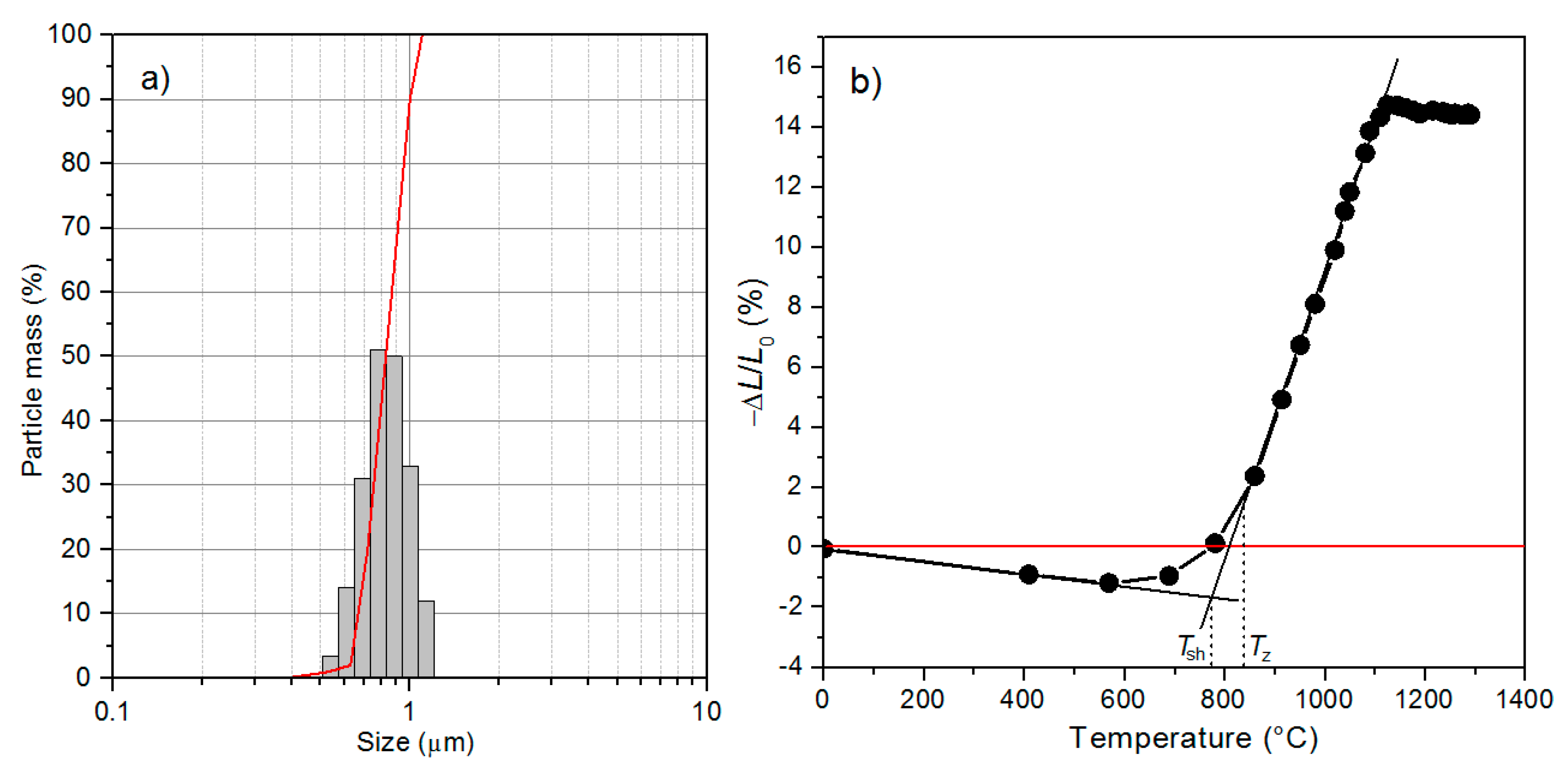
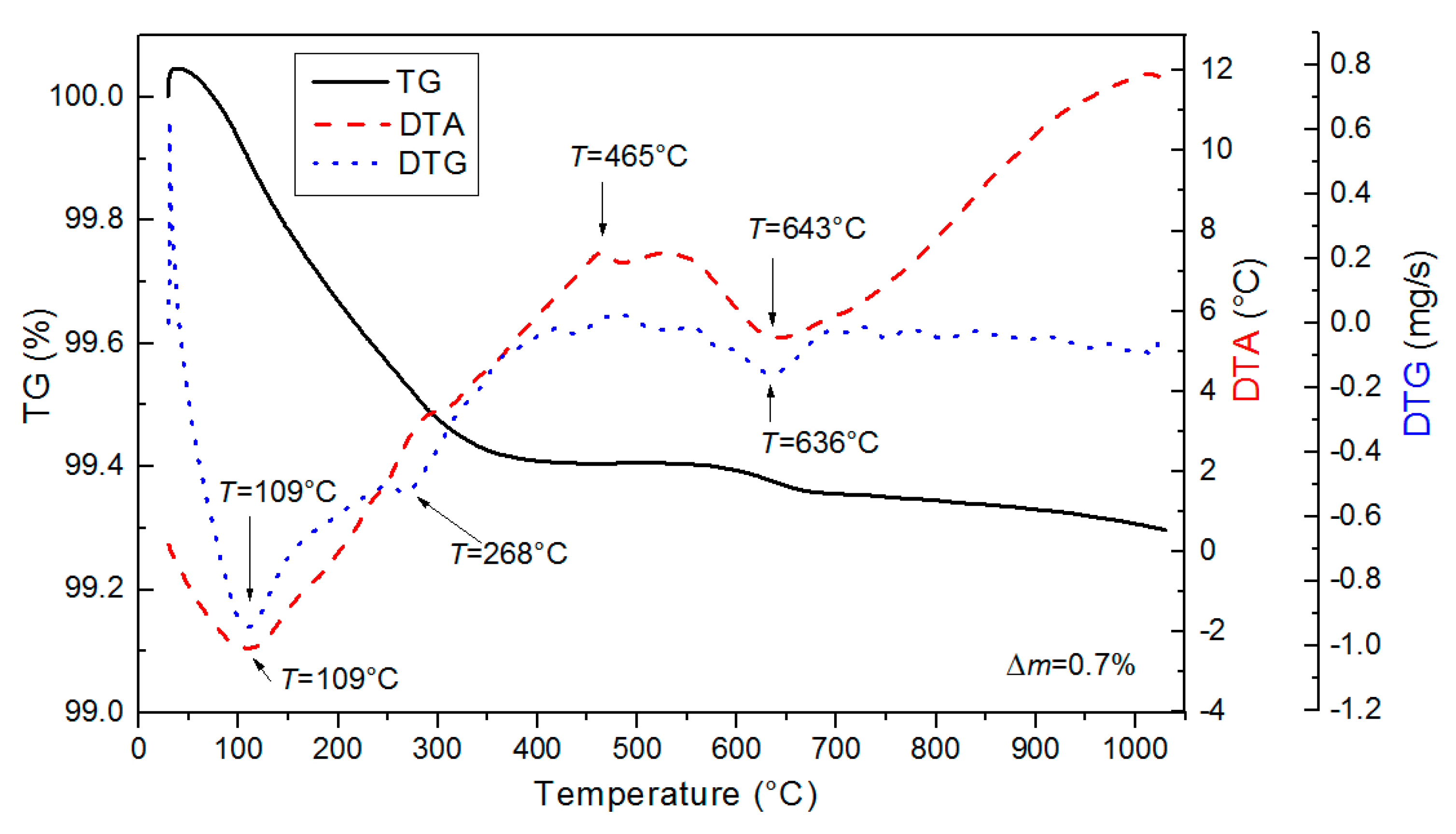
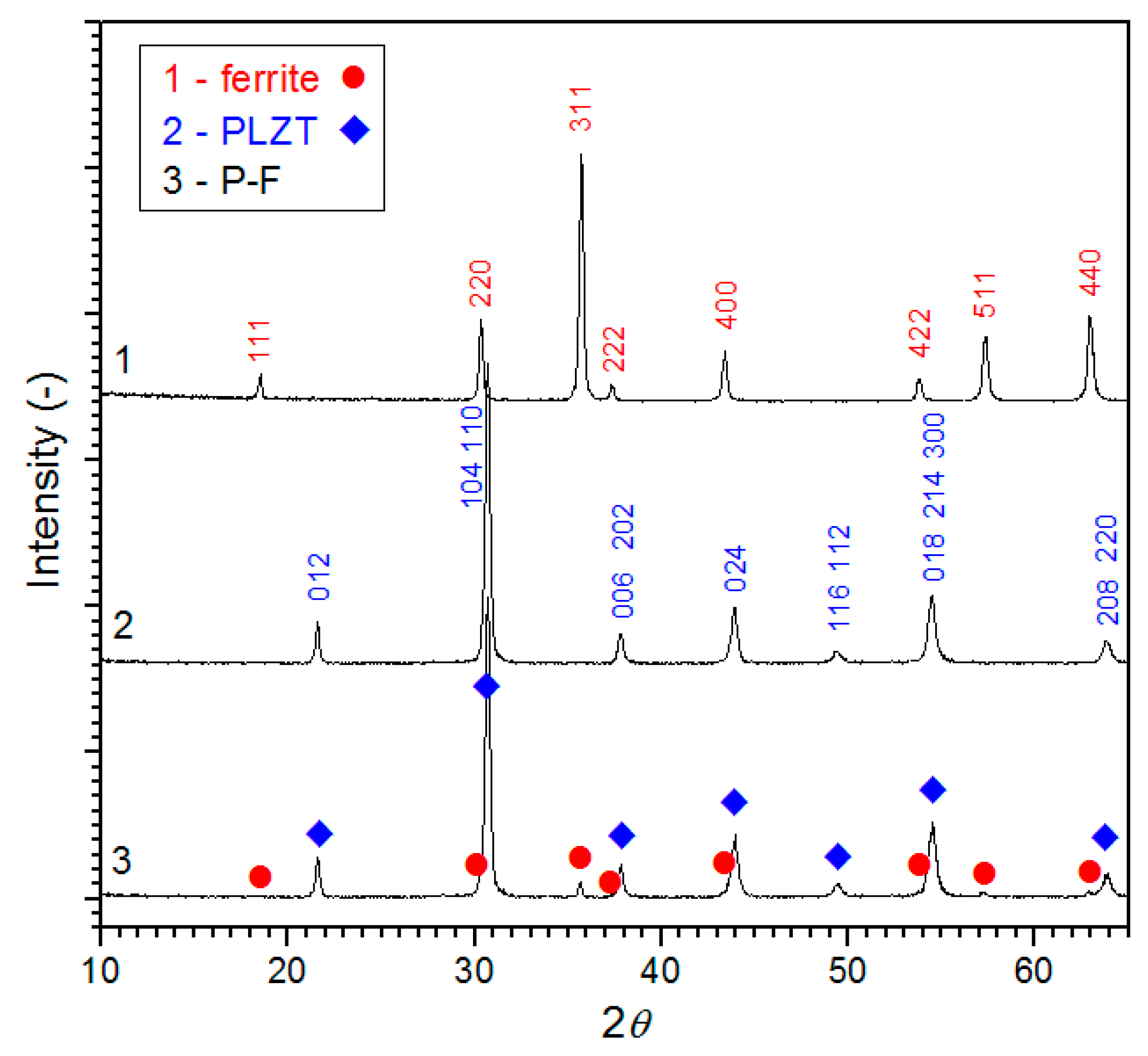
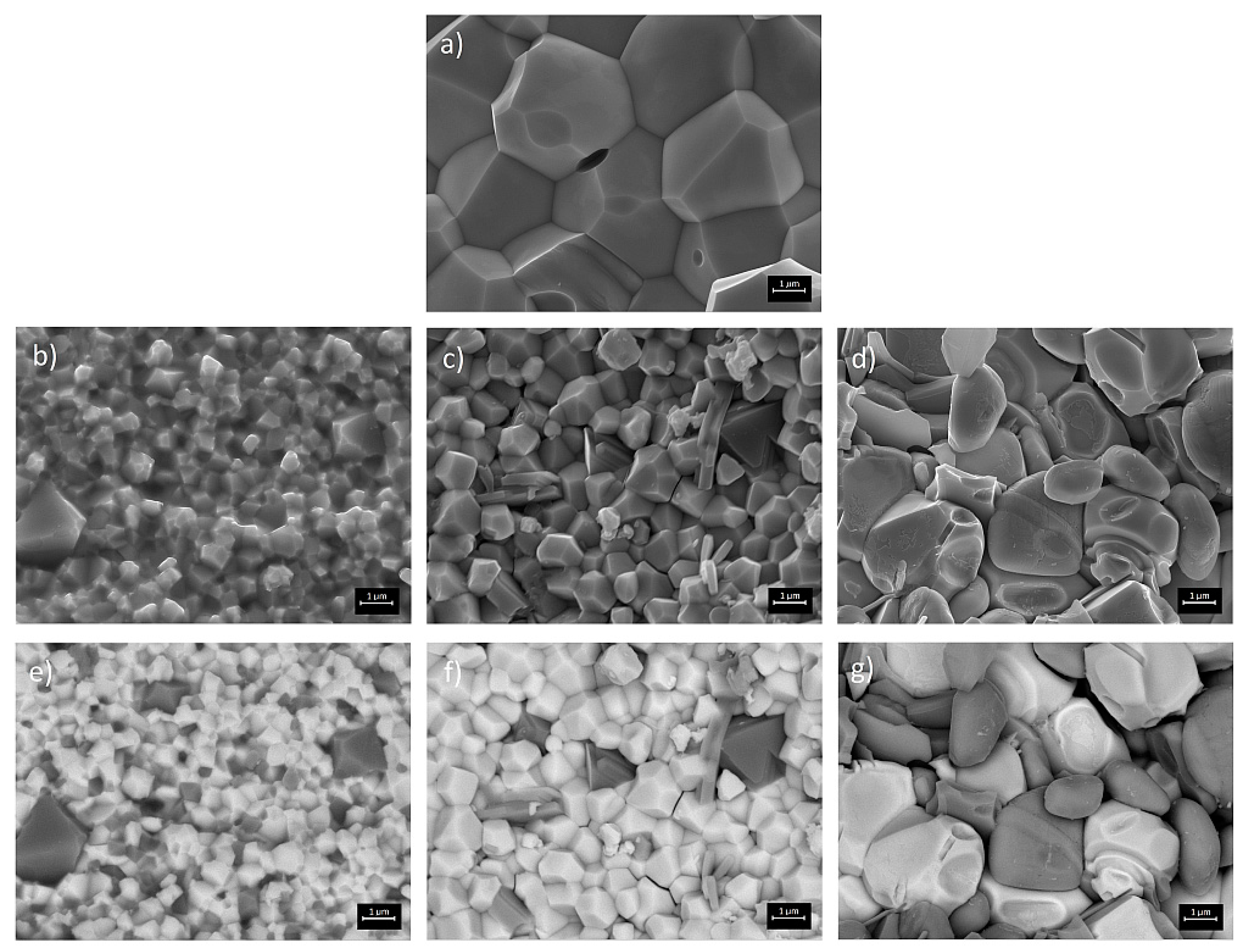
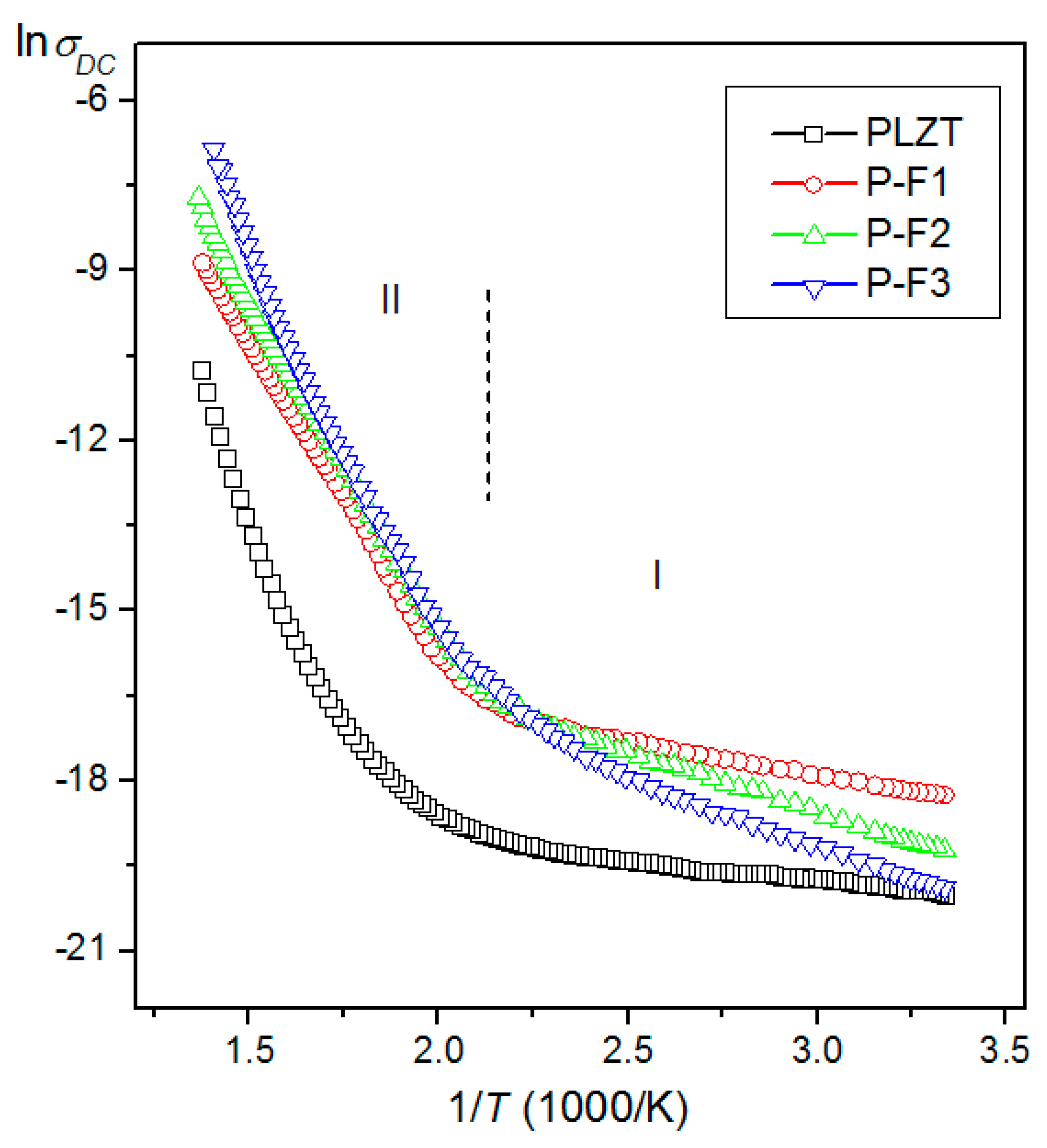
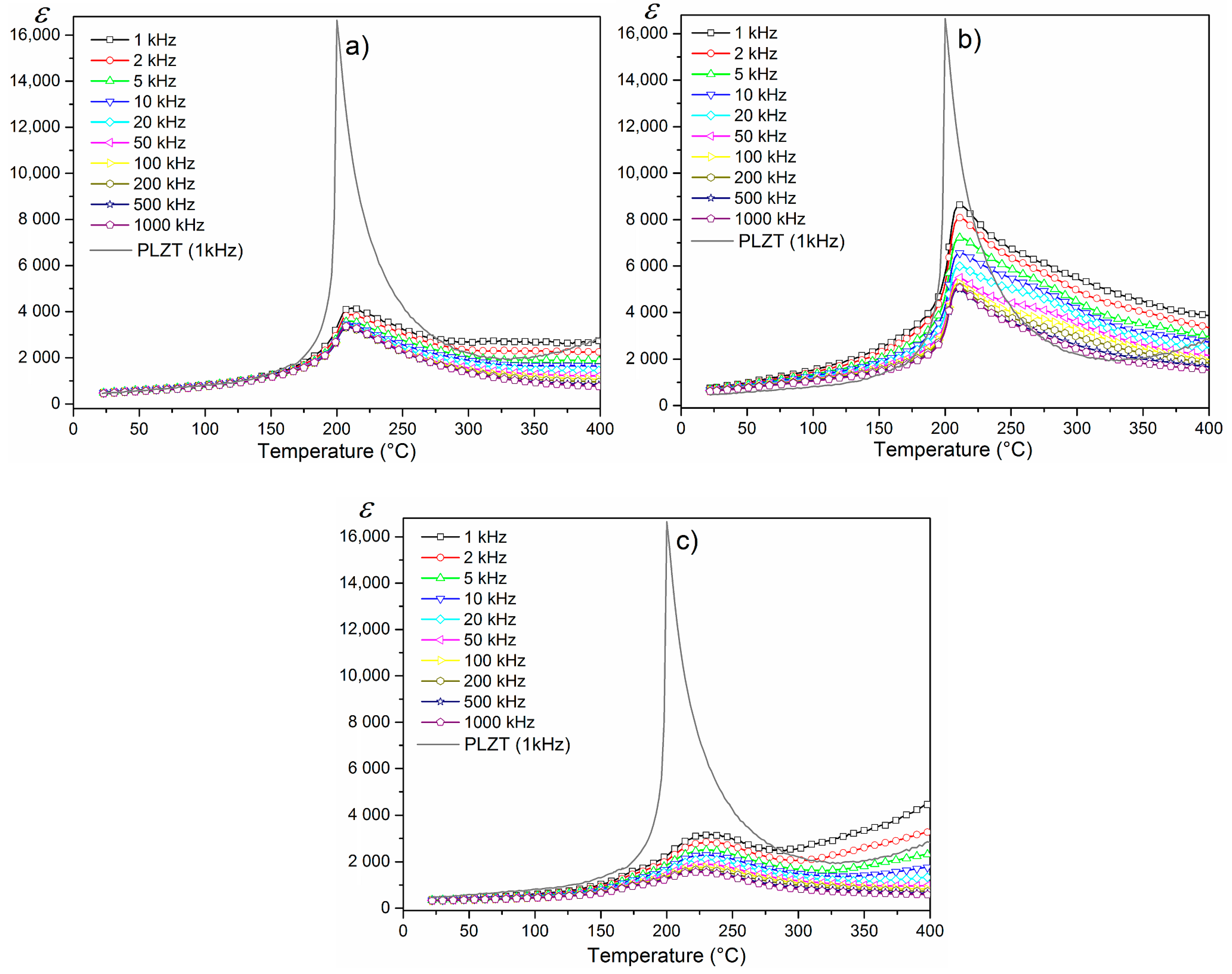
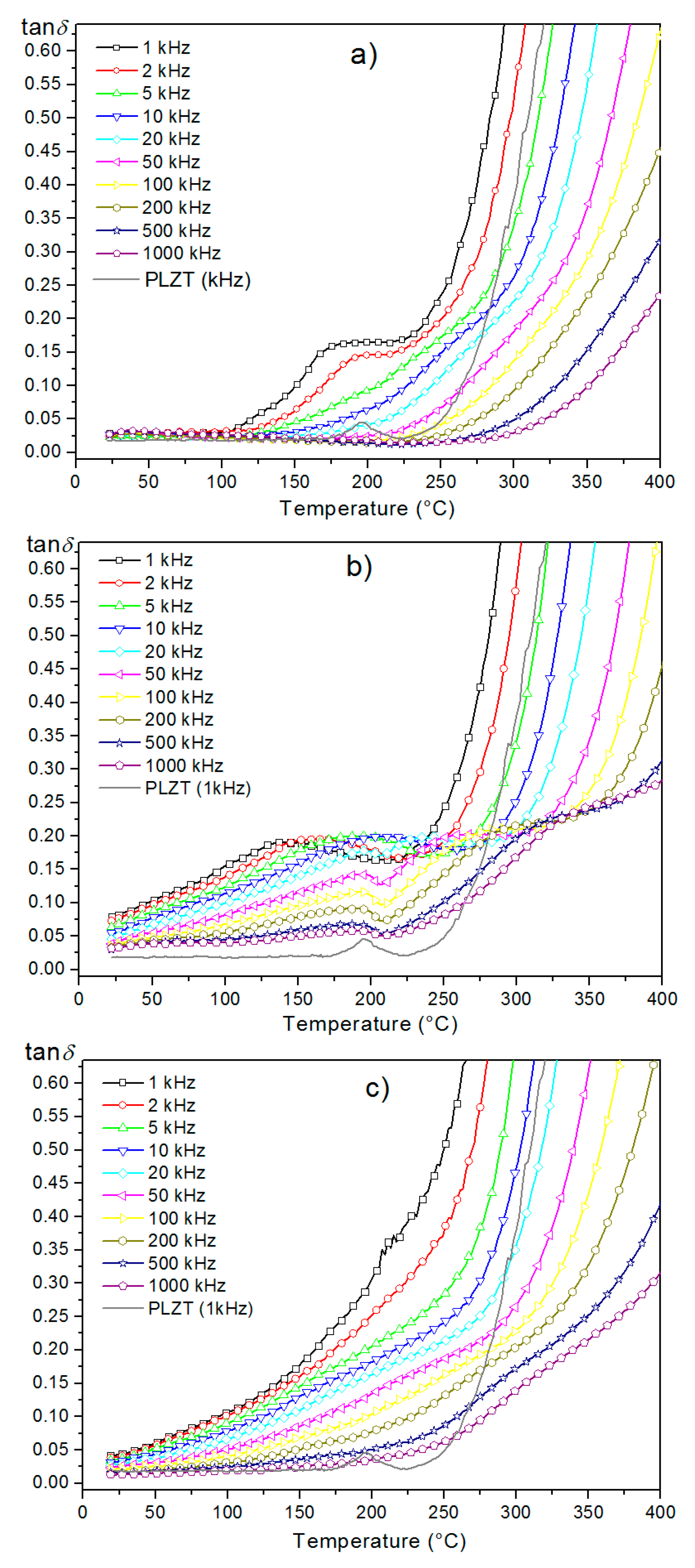
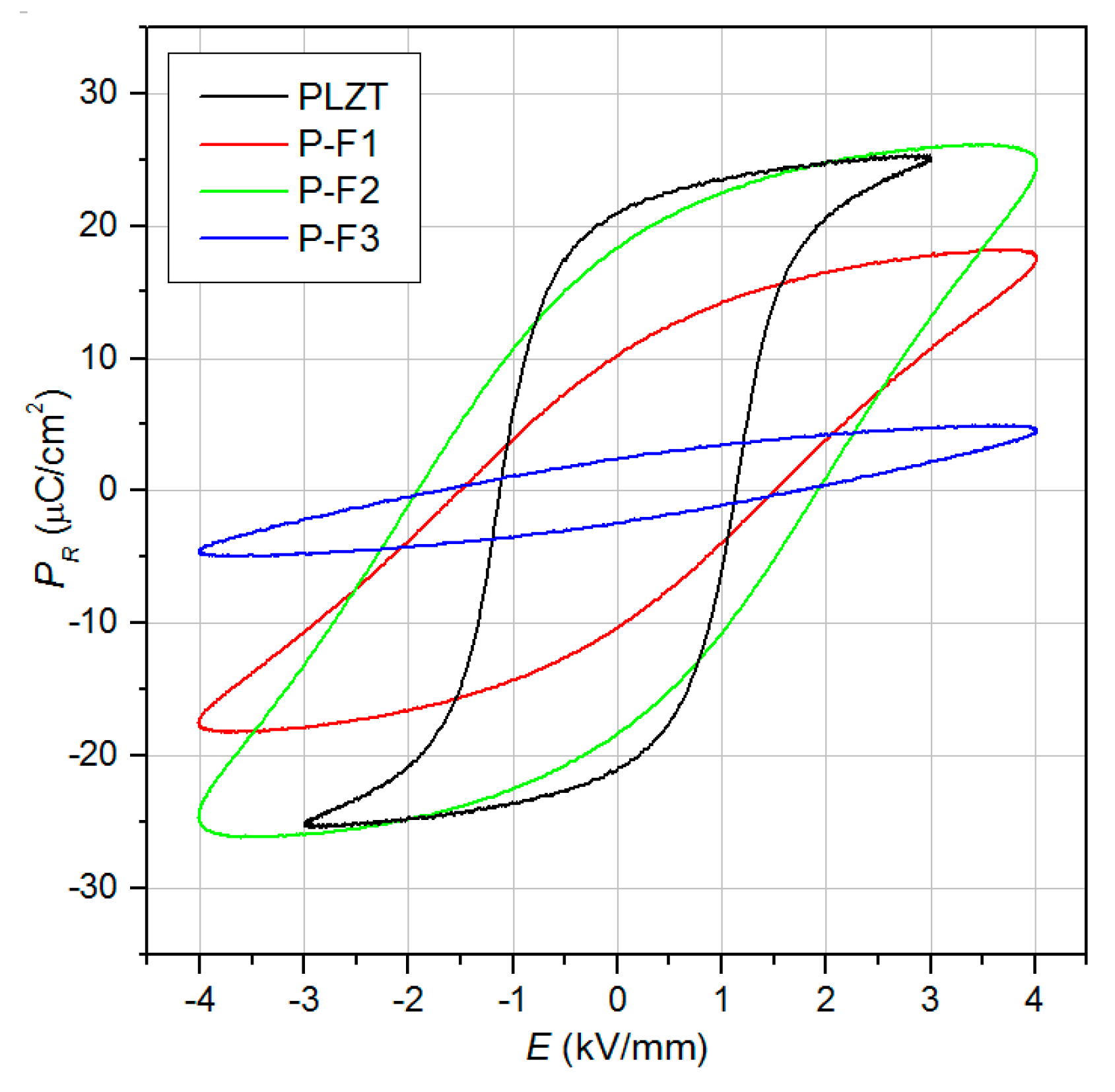
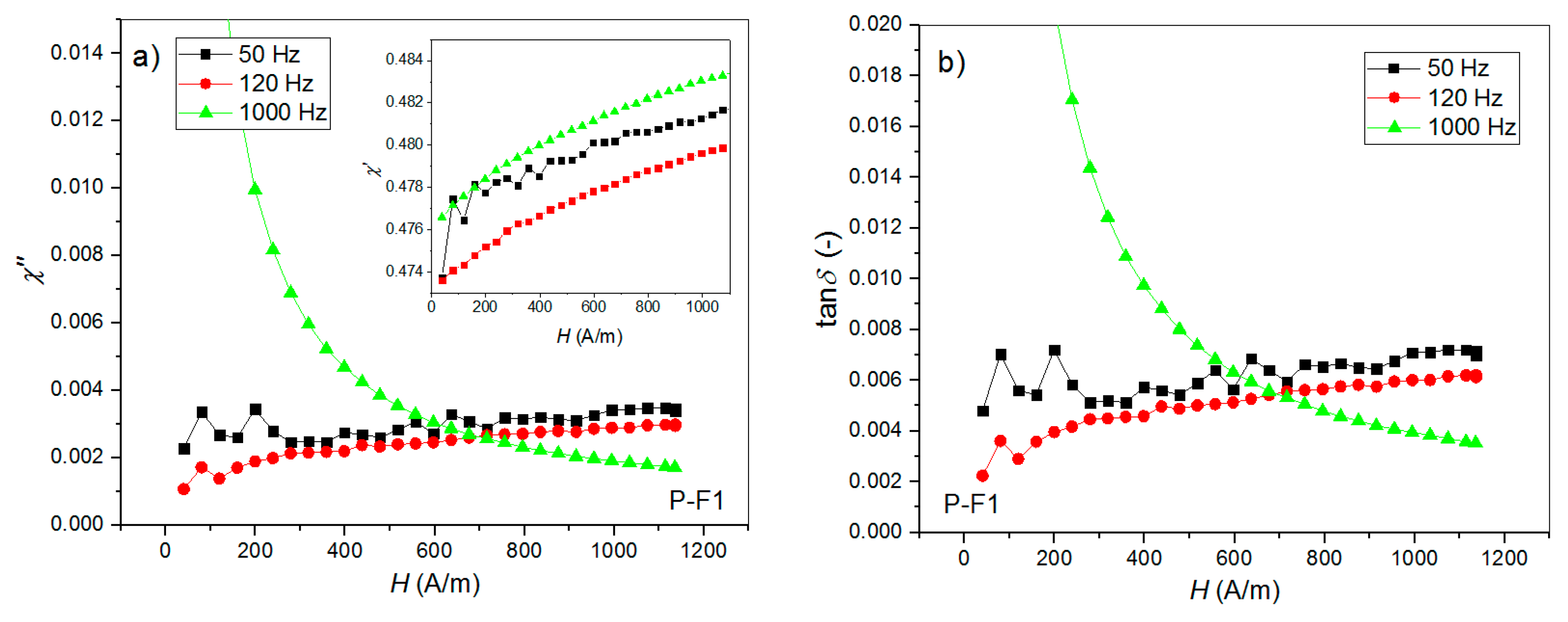
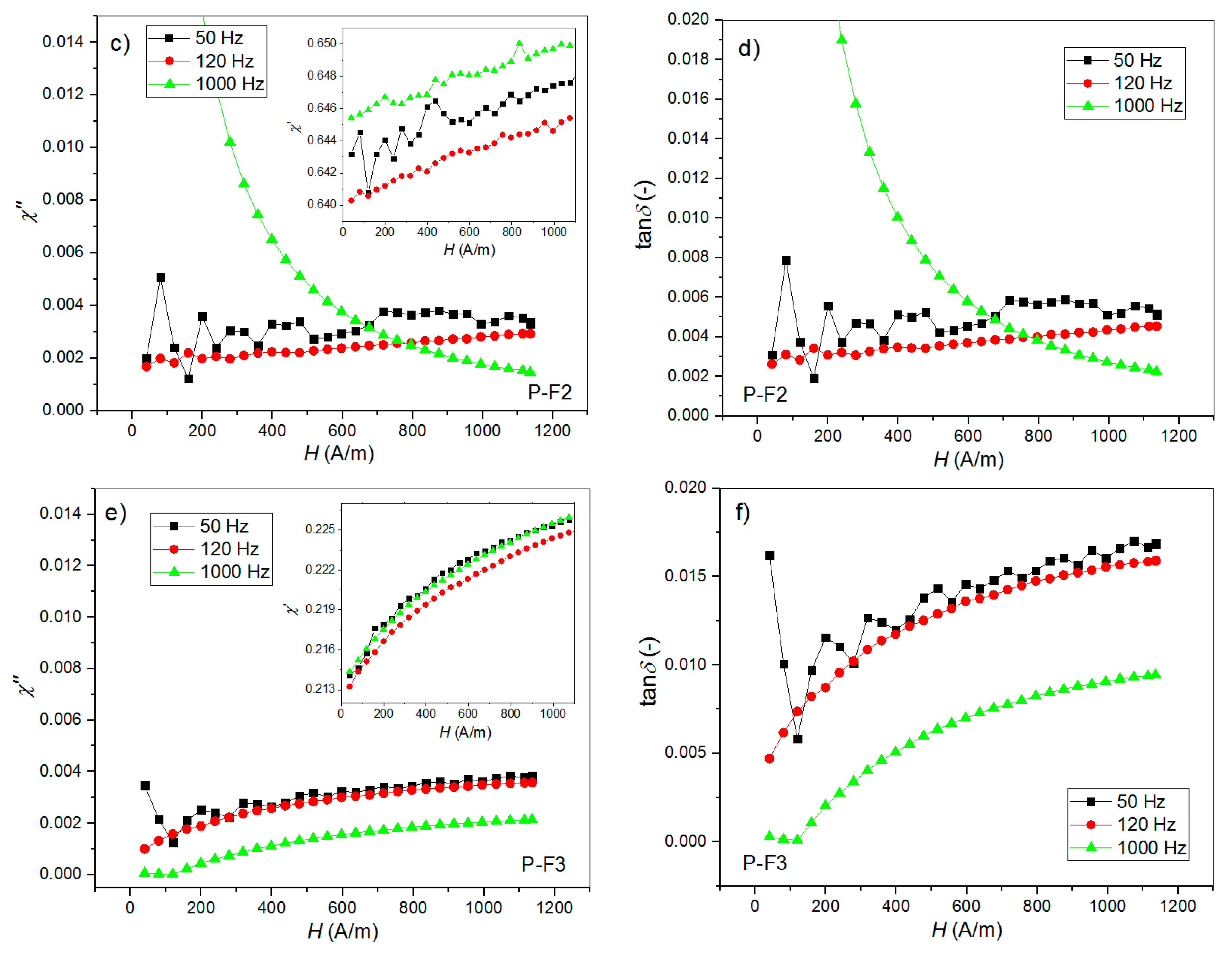
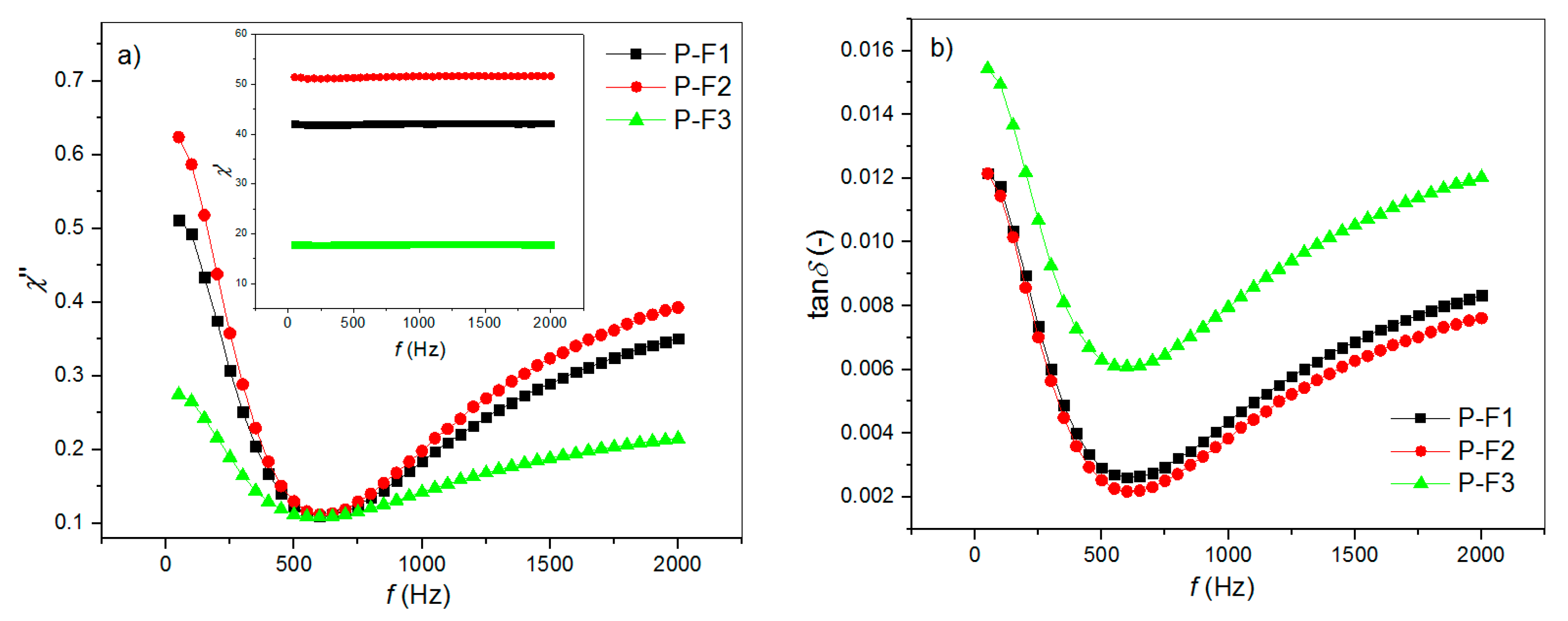
| Oxide Formula | P-F | P-F1 | P-F2 | P-F3 |
|---|---|---|---|---|
| Theoretical (%) | Experimental (%) | Experimental (%) | Experimental (%) | |
| PbO | 55.389 | 52.44 | 53.7 | 49.49 |
| La2O3 | 0.889 | 0.61 | 0.74 | 0.73 |
| ZrO2 | 30.099 | 31.75 | 30.63 | 36.99 |
| TiO2 | 2.603 | 2.39 | 2.88 | 2.21 |
| NiO | 1.449 | 2.11 | 1.41 | 1.28 |
| ZnO | 0.888 | 0.93 | 0.95 | 0.84 |
| Fe2O3 | 9.681 | 9.77 | 9.69 | 8.46 |
| Parameter | PLZT | P-F1 | P-F2 | P-F3 |
|---|---|---|---|---|
| ρ (g/cm3) | 7.20 | 7.07 | 7.17 | 6.90 |
| TC (°C) 1 | 200 | 211 | 211 | 233 |
| εr at Tr 1 | 460 | 496 | 747 | 376 |
| εmax at TC 1 | 16,646 | 4141 | 8633 | 3247 |
| tanδ at Tr 1 | 0.018 | 0.029 | 0.079 | 0.041 |
| tanδ at TC 1 | 0.041 | 0.165 | 0.164 | 0.417 |
| EAct in I (eV) | 0.063 | 0.108 | 0.190 | 0.239 |
| EAct in II (eV) | 0.903 | 0.934 | 0.993 | 1.145 |
| EC (kV/mm) 2 | 1.40 | 1.50 | 1.91 | 1.70 |
| Pr (μC/cm2) 2 | 21.10 | 10.25 | 18.15 | 2.5 |
© 2018 by the authors. Licensee MDPI, Basel, Switzerland. This article is an open access article distributed under the terms and conditions of the Creative Commons Attribution (CC BY) license (http://creativecommons.org/licenses/by/4.0/).
Share and Cite
Bochenek, D.; Niemiec, P.; Korzekwa, J.; Durtka, B.; Stokłosa, Z. Microstructure and Properties of the Ferroelectric-Ferromagnetic PLZT-Ferrite Composites. Symmetry 2018, 10, 59. https://doi.org/10.3390/sym10030059
Bochenek D, Niemiec P, Korzekwa J, Durtka B, Stokłosa Z. Microstructure and Properties of the Ferroelectric-Ferromagnetic PLZT-Ferrite Composites. Symmetry. 2018; 10(3):59. https://doi.org/10.3390/sym10030059
Chicago/Turabian StyleBochenek, Dariusz, Przemysław Niemiec, Joanna Korzekwa, Bartłomiej Durtka, and Zbigniew Stokłosa. 2018. "Microstructure and Properties of the Ferroelectric-Ferromagnetic PLZT-Ferrite Composites" Symmetry 10, no. 3: 59. https://doi.org/10.3390/sym10030059
APA StyleBochenek, D., Niemiec, P., Korzekwa, J., Durtka, B., & Stokłosa, Z. (2018). Microstructure and Properties of the Ferroelectric-Ferromagnetic PLZT-Ferrite Composites. Symmetry, 10(3), 59. https://doi.org/10.3390/sym10030059





